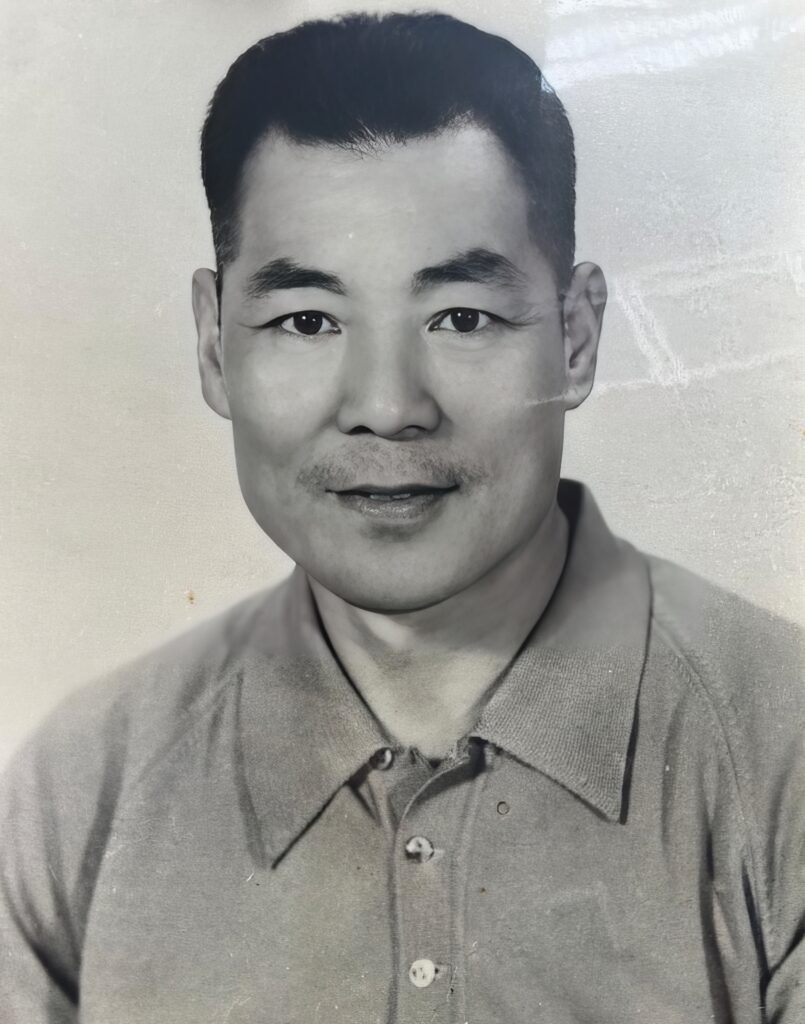
Great Grand Master Fung Cheung
Fung Chiu-chun (1921-2012), more commonly known as Fung Chun, was born in 1921 in Longxi Mubian neighborhood, Gu Lao Village, He Shan County. Due to his sturdy physique, the locals gave him the nickname ”Da Luk Chun” Big Robust Chun.
Fung Chun began practicing martial arts at the age of 17, studying under Wong Wah Sam, a direct disciple of Dr Leung Jan, the well-known King of Wing Chun in Heshan. His martial arts skills were a perfect blend of hardness and softness, characterized by the nimbleness and swiftness of the body and hand techniques, agile footwork, and the ability to advance and recede freely. Grandmaster Fung Chun was skilled in using short bridge and Butterfly Palm techniques, renowned for his ability to generate inch power and excel in executing short strikes and side body attacks. At the same time, he was adept in sticking hands, had strong tactile sensitivity and fast reactions. He was equally famous for his mastery of the three-and-a-half pole skills.
Throughout his life, Fung Chun was dedicated to studying, researching and imparting his knowledge of Side Body Wing Chun. He transmitted his full knowledge to his two sons, Fung Yim Leung and Fung Yim Keung, as well as many disciples, including Fung Gen-Chu, Zhou Sen, Li Wei-Qiang, Li Wen-Qi, and Yang Bing-Can. His disciples are dispersed across the globe. The Side Body Wing Chun that he passed down was recognized by the Guangdong Provincial Department of Culture as an Intangible Cultural Heritage of Guangdong Province. Fung Chun was well-respected by the younger generations and was acknowledged as the Grandmaster of his generation.
Living through the tumultuous times of The War of Resistance against Japanese Aggression (1937-1945), Fung Chun faced numerous incidents that required him to apply his martial skills in fighting against various adversaries.
In 1939, he seized the opportunity to transport grain to the San Zhou region and he defeated the bandits who were wreaking havoc there.
Obeying his master’s orders, together with Lau Wei-kin, Grandmaster Fung Chun joined the West River Resist-Japanese Guerrilla Unit, organized by Gu Wen. During a mission to transport grain to alleviate the food shortage faced by the Resist-Japanese forces, Grandmaster Fung Chun was obstructed by Japanese soldiers, and he defeated two of them, ensuring that the grain was delivered safely to the Resist-Japanese forces.
In the summer of 1942, Fung Chiu-chun received a mission from his superiors to infiltrate Jie Zhou Village, located at the foot of Da Yan Mountain. He successfully sabotaged the Japanese telecommunication lines, effectively hindering the Japanese military’s communication transmission, hence significantly aiding the guerrilla forces in their fight against the Japanese.
In the spring of 1944, shortage of salt occurred as the route from Gao Ming San Zhou Hui to Gu Lao was obstructed by Japanese forces. This supply shortage posed a serious threat to the survival of the guerrilla fighters. Fung Chun received instructions from his superiors to lead a team of five men to the San Zhou Hui to purchase salt. On their way back, they encountered a Japanese soldier and a Chinese traitor who tried to confiscate their salt. In such critical moment, Fung Chun swiftly grabbed a bamboo pole to thrust at the Japanese soldier. He then immediately turned his body using the pole to strike the traitor’s neck. He seized the gun from the traitor’s waist and quickly left the scene. He was able to deliver the salt to the troops on time.
After the victory of the Resistance against Japanese Aggression war, Fung Chiu-chun followed his master’s instructions to continue studying Wing Chun martial arts in anonymity, concealing his name and hiding his real identity.
In 1958, Fung Chiu-chun moved to Guangzhou to make a living as a manual labor.
In 1964, Fung Chiu-chun and his disciple Fung Gen-Chu moved to Hong Kong, initially employed as manual labor and later as operator of street market stall. He always harbored a chivalrous spirit and often stood up for his fellow workers.
In 2000, Fung Chiu-Chun returned to Gu Lao to spend his later years in peace and tranquility. Nonetheless, he continued to tirelessly promote Wing Chun, achieving remarkable results.
In 2007, Heshan Wing Chun Kuen was successfully registered as an intangible cultural heritage protection project by the Guangdong Provincial Department of Culture. In recognition of Fung Chiu-chun’s outstanding contributions to Wing Chun Kuen during his lifetime, he was awarded the title of Key Successor of Heshan Wing Chun Kuen by the Guangdong Provincial Department of Culture.
On the morning of September 13, 2012, Fung Chiu-chun passed away at his home in Gu Lao at the age of 92.
Source:
Heshan City Bureau of Culture, Press, Publication, Radio, Film and Television &
Heshan City Federation of Literary and Art Circles:
”Founding Patriarch – Heshan Leung Jan Wing Chun Kuen”, Year 2015, pp. 47-51